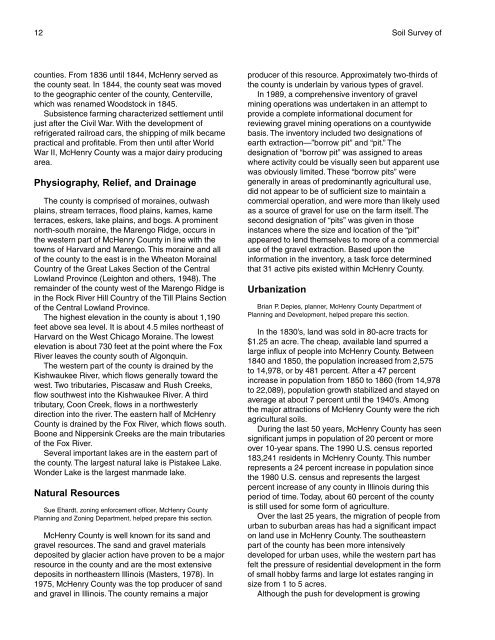Soil Survey of McHenry County, Illinois Part I - Soil Data Mart
Soil Survey of McHenry County, Illinois Part I - Soil Data Mart
Soil Survey of McHenry County, Illinois Part I - Soil Data Mart
Create successful ePaper yourself
Turn your PDF publications into a flip-book with our unique Google optimized e-Paper software.
12 <strong>Soil</strong> <strong>Survey</strong> <strong>of</strong><br />
counties. From 1836 until 1844, <strong>McHenry</strong> served as<br />
the county seat. In 1844, the county seat was moved<br />
to the geographic center <strong>of</strong> the county, Centerville,<br />
which was renamed Woodstock in 1845.<br />
Subsistence farming characterized settlement until<br />
just after the Civil War. With the development <strong>of</strong><br />
refrigerated railroad cars, the shipping <strong>of</strong> milk became<br />
practical and pr<strong>of</strong>itable. From then until after World<br />
War II, <strong>McHenry</strong> <strong>County</strong> was a major dairy producing<br />
area.<br />
Physiography, Relief, and Drainage<br />
The county is comprised <strong>of</strong> moraines, outwash<br />
plains, stream terraces, flood plains, kames, kame<br />
terraces, eskers, lake plains, and bogs. A prominent<br />
north-south moraine, the Marengo Ridge, occurs in<br />
the western part <strong>of</strong> <strong>McHenry</strong> <strong>County</strong> in line with the<br />
towns <strong>of</strong> Harvard and Marengo. This moraine and all<br />
<strong>of</strong> the county to the east is in the Wheaton Morainal<br />
Country <strong>of</strong> the Great Lakes Section <strong>of</strong> the Central<br />
Lowland Province (Leighton and others, 1948). The<br />
remainder <strong>of</strong> the county west <strong>of</strong> the Marengo Ridge is<br />
in the Rock River Hill Country <strong>of</strong> the Till Plains Section<br />
<strong>of</strong> the Central Lowland Province.<br />
The highest elevation in the county is about 1,190<br />
feet above sea level. It is about 4.5 miles northeast <strong>of</strong><br />
Harvard on the West Chicago Moraine. The lowest<br />
elevation is about 730 feet at the point where the Fox<br />
River leaves the county south <strong>of</strong> Algonquin.<br />
The western part <strong>of</strong> the county is drained by the<br />
Kishwaukee River, which flows generally toward the<br />
west. Two tributaries, Piscasaw and Rush Creeks,<br />
flow southwest into the Kishwaukee River. A third<br />
tributary, Coon Creek, flows in a northwesterly<br />
direction into the river. The eastern half <strong>of</strong> <strong>McHenry</strong><br />
<strong>County</strong> is drained by the Fox River, which flows south.<br />
Boone and Nippersink Creeks are the main tributaries<br />
<strong>of</strong> the Fox River.<br />
Several important lakes are in the eastern part <strong>of</strong><br />
the county. The largest natural lake is Pistakee Lake.<br />
Wonder Lake is the largest manmade lake.<br />
Natural Resources<br />
Sue Ehardt, zoning enforcement <strong>of</strong>ficer, <strong>McHenry</strong> <strong>County</strong><br />
Planning and Zoning Department, helped prepare this section.<br />
<strong>McHenry</strong> <strong>County</strong> is well known for its sand and<br />
gravel resources. The sand and gravel materials<br />
deposited by glacier action have proven to be a major<br />
resource in the county and are the most extensive<br />
deposits in northeastern <strong>Illinois</strong> (Masters, 1978). In<br />
1975, <strong>McHenry</strong> <strong>County</strong> was the top producer <strong>of</strong> sand<br />
and gravel in <strong>Illinois</strong>. The county remains a major<br />
producer <strong>of</strong> this resource. Approximately two-thirds <strong>of</strong><br />
the county is underlain by various types <strong>of</strong> gravel.<br />
In 1989, a comprehensive inventory <strong>of</strong> gravel<br />
mining operations was undertaken in an attempt to<br />
provide a complete informational document for<br />
reviewing gravel mining operations on a countywide<br />
basis. The inventory included two designations <strong>of</strong><br />
earth extraction—”borrow pit” and “pit.” The<br />
designation <strong>of</strong> “borrow pit” was assigned to areas<br />
where activity could be visually seen but apparent use<br />
was obviously limited. These “borrow pits” were<br />
generally in areas <strong>of</strong> predominantly agricultural use,<br />
did not appear to be <strong>of</strong> sufficient size to maintain a<br />
commercial operation, and were more than likely used<br />
as a source <strong>of</strong> gravel for use on the farm itself. The<br />
second designation <strong>of</strong> “pits” was given in those<br />
instances where the size and location <strong>of</strong> the “pit”<br />
appeared to lend themselves to more <strong>of</strong> a commercial<br />
use <strong>of</strong> the gravel extraction. Based upon the<br />
information in the inventory, a task force determined<br />
that 31 active pits existed within <strong>McHenry</strong> <strong>County</strong>.<br />
Urbanization<br />
Brian P. Depies, planner, <strong>McHenry</strong> <strong>County</strong> Department <strong>of</strong><br />
Planning and Development, helped prepare this section.<br />
In the 1830’s, land was sold in 80-acre tracts for<br />
$1.25 an acre. The cheap, available land spurred a<br />
large influx <strong>of</strong> people into <strong>McHenry</strong> <strong>County</strong>. Between<br />
1840 and 1850, the population increased from 2,575<br />
to 14,978, or by 481 percent. After a 47 percent<br />
increase in population from 1850 to 1860 (from 14,978<br />
to 22,089), population growth stabilized and stayed on<br />
average at about 7 percent until the 1940’s. Among<br />
the major attractions <strong>of</strong> <strong>McHenry</strong> <strong>County</strong> were the rich<br />
agricultural soils.<br />
During the last 50 years, <strong>McHenry</strong> <strong>County</strong> has seen<br />
significant jumps in population <strong>of</strong> 20 percent or more<br />
over 10-year spans. The 1990 U.S. census reported<br />
183,241 residents in <strong>McHenry</strong> <strong>County</strong>. This number<br />
represents a 24 percent increase in population since<br />
the 1980 U.S. census and represents the largest<br />
percent increase <strong>of</strong> any county in <strong>Illinois</strong> during this<br />
period <strong>of</strong> time. Today, about 60 percent <strong>of</strong> the county<br />
is still used for some form <strong>of</strong> agriculture.<br />
Over the last 25 years, the migration <strong>of</strong> people from<br />
urban to suburban areas has had a significant impact<br />
on land use in <strong>McHenry</strong> <strong>County</strong>. The southeastern<br />
part <strong>of</strong> the county has been more intensively<br />
developed for urban uses, while the western part has<br />
felt the pressure <strong>of</strong> residential development in the form<br />
<strong>of</strong> small hobby farms and large lot estates ranging in<br />
size from 1 to 5 acres.<br />
Although the push for development is growing

















